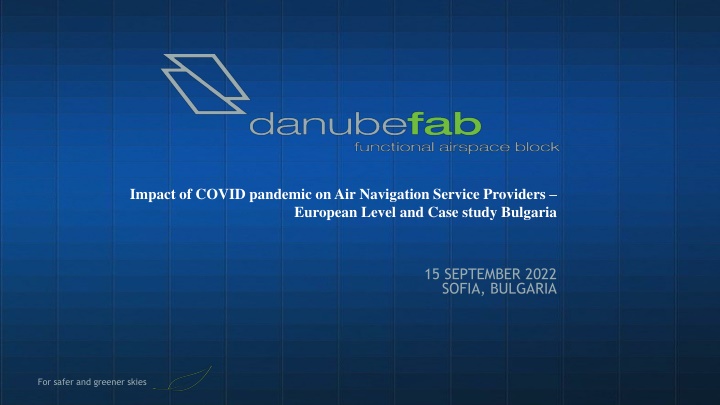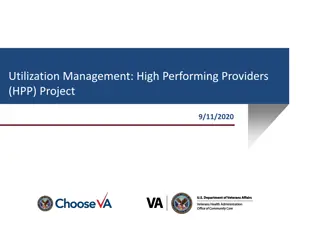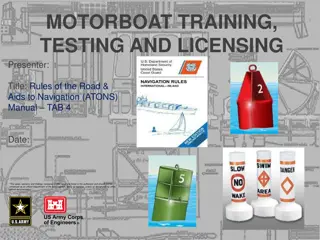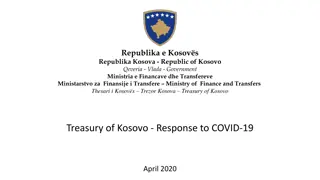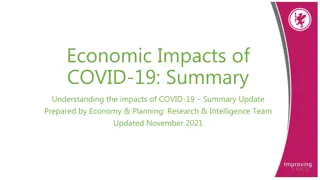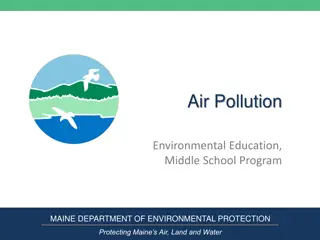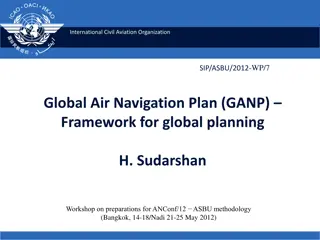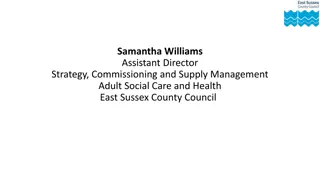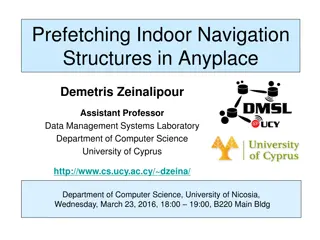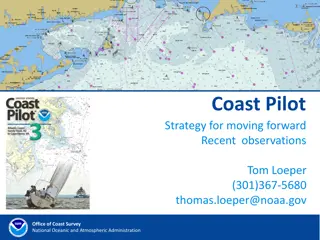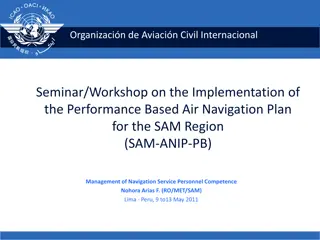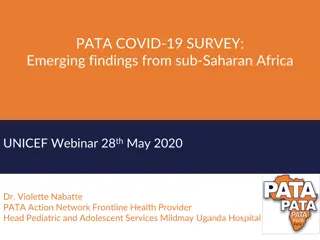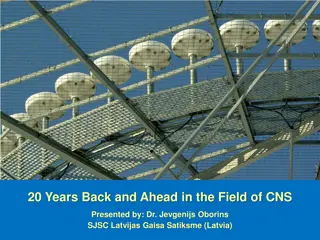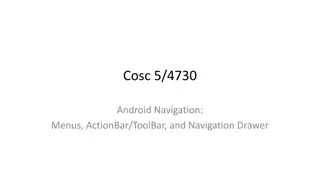Impact of COVID Pandemic on European Air Navigation Providers
The impact of the COVID-19 pandemic on Air Navigation Service Providers in Europe, with a specific case study on Bulgaria. Exploring the challenges faced, changes in air traffic, and strategies for recovery and resilience in the aviation industry.
Download Presentation

Please find below an Image/Link to download the presentation.
The content on the website is provided AS IS for your information and personal use only. It may not be sold, licensed, or shared on other websites without obtaining consent from the author.If you encounter any issues during the download, it is possible that the publisher has removed the file from their server.
You are allowed to download the files provided on this website for personal or commercial use, subject to the condition that they are used lawfully. All files are the property of their respective owners.
The content on the website is provided AS IS for your information and personal use only. It may not be sold, licensed, or shared on other websites without obtaining consent from the author.
E N D
Presentation Transcript
Impact of COVID pandemic on Air Navigation Service Providers European Level and Case study Bulgaria 15 SEPTEMBER 2022 SOFIA, BULGARIA For safer and greener skies
SETTING THE SCENE OVER RP2 2015-2019 AND RP3 2020-2024 NOV 2019: TRAFFIC RUNNING AT FULL THROTTLE, MORE CAPACITY OVER RP3 IS OF ESSESENCE SERVICE UNITS (MILLIONS) EUROCONTROL AREA 210 193 188 183 178 190 173 167 163 170 153 143 138 150 132 130 110 90 70 50 NOV 2019 14A 15A 16A 17A 18A 19A 20F 21F 22F 23F 24F 2
SETTING THE SCENE OVER RP2 2015-2019 AND RP3 2020-2024 2020:COMPLETE HALT QUO VADIS WILL TRAFFIC BE EVER COMING BACK? SERVICE UNITS (MILLIONS) EUROCONTROL AREA 250 193 178 156 188 164 137 108 183 178 200 173 167 167 167 167 163 163 163 163 153 153 153 153 147 143 143 143 143 138 138 138 138 132 132 132 132 150 123 116 92 115 77 75 100 71 69 68 50 14A 15A 16A 17A 18A 19A 20F 21F 22F 23F 24F NOV 2019 NOV 2020 SC1 NOV 2020 SC2 NOV 2020 SC3 Uncertain legislative perspective: Performance Scheme Y/N? New EU-wide targets or full cost recovery? ANSP costs and losses? ANSPs capabilities to generate revenue? State aid? Liquidity, low unit rates, charges deferral? Investments and ATCOs recruitment? 3
ANSPs FEATURES AND ENDOGENOUS CHARACTERISTICS High operating leverage (OL) main reasons: 24/7 operations and the need for meeting all requirements to ensure safety regardless of traffic levels Long minimal planning horizon 5 to 10 years main reasons: complex projects and time-consuming training processes; needed to ensure safety 1. Boils down to an analysis of fixed costs (FC) and variable costs (VC). 2. Highest in companies that have a high proportion of FC in relation to VC. This kind of company uses more fixed assets in its operations; 3. Occurs when a company has FC that must be met regardless of sales volume; 4. How sensitive a company's operating income is to a change in revenue streams is measured by the degree of operating leverage (DOL). DOL directly reflects company's cost structure (being a significant variable when determining profitability). E.g. if normally EBIT is EUR10M, but turns into a loss of (EUR 40m) because of 60% decrease in sales, then 1. ATCO training period 2-4 years 2. ATM/CNS projects are complex and time consuming > 2 years if R&D is heavily involved 3. Planning horizon 5 years, 5-10 years CONCLUSIONS: ANSPs must find ways to acquire human and technical resources to meet high traffic demand in more flexible ways (Operational resilience) ANSPs must find ways to manage activities and costs in more flexible ways (Financial resilience) ANSPs must act in preventive manner with sufficient lead time Medium- and long-term objectives for ANSPs prevail over short-term objectives ?? ( ??) ?? ?? ??? ??? ???% ??%= ?,?? ! DOL = = 5. If FC are high difficult to manage short-term revenue fluctuation, because expenses are incurred regardless of levels of sales; Companies with high risk and high degrees of operating leverage find it harder to obtain cheap financing (impacts cost of equity!); 6. The benefits of high OL can be immense. Companies with high OL can make more money from each additional sale if they don't have to increase costs to produce more sales (economies of scale which are not endless; expectations to reduce ANS charges). 4
RESILIENCE OF ANSPs LINKS TO CHARGES ANSP PERSPECTIVE USERS/AIRLINES PERSPECTIVE 1. Charges comprise almost 100% of ANSP income, as a rule 2. Bear all costs for human and technical resources to ensure service provision, maintenance and development of critical infrastructure 3. No commitment on users side for traffic volume, thus mechanisms to offset variances between forecasted and actual traffic are in place 4. Regulation and applicable legislation have to ensure legal certainty and ability to generate revenue (different than overcoming liquidity issues) 5. Must prioritise medium-and long-term objectives over short-terms ones in a cost- efficient manner. This would not change users' cost structure and would be bearable compared to daily problems related to unsafe and low-quality service provision, especially when traffic is high. 6. Focus on meaningful interdependency concept and total economic costs of service provision (SAF, CAP, ENV, CEF) 7. Actions are to be taken in preventive manner 1. ANS charges comprise some 5% of airlines costs 2. Charges have to encourage the use of ANS facilities and services 3. Pay via user charges for the use of service provision and critical infrastructure only when actively flying (thus, should it be expected that ANS charges be covered by passengers/cargo clients money, as a rule?) 4. Not asked to finance service provision when flights are not performed but asked to cover ANSP losses because of lower than planned charges (when demand is back) 5
BULATSA CASE STUDY RP2 DEVELOPMENT RP3 DEVELOPMENT 1. 2013: ~ 500,000 flights; 2019 : ~ 900,000 flights; SU doubled 2. Lack of clarity on the use of Simferopol FIR and Dnipropetrovsk FIR airspaces given the ease of regulatory bans (BIG Impact) 3. Uncertainty related to Iraq/Iran/Syrian airspaces (BIG Impact) 4. Increased complexity of operations (X-MAN for LTFM) 5. Application of and focus on meaningful interdependency concept and total economic costs of service provision (SAF, CAP, ENV, CEF) 6. Actions taken in preventive manner 7. Intensive measures: very flexible ATCOs roster (up to 22 shifts), cross training 8. Extensive measures: recruitment of additional ATCOs, new investments 9. En-route unit rate (EUR): about 30; 10. Revision of RP2 PP and ZERO delays 1. 2020: ~ 380,000 flights; 2021 ~ 520,000 flights; SU halved 2. Lack of clarity on the use of Simferopol FIR and Dnipropetrovsk FIR airspaces given the ease of regulatory bans (BIG Impact) 3. Increased uncertainty related to Iraq, Iran, Syria, Afghanistan, (Nagorno- Karabakh conflict) airspaces (BIG Impact) 4. Application of and focus on meaningful interdependency concept and total economic costs of service provision (SAF, CAP, ENV, CEF) 5. Actions taken in preventive manner 6. Measures to limit spread of COVID-19 among operational and administrative staff. ATCOs organised in teams, part of ATCOs allocated to work on projects 7. Immediate salaries cut from March 2020 for all staff by 30% - applied for more than 24 months. All performance related payments under the collective labour agreement were also ceased 8. All operating costs limited to those necessary to maintain operations, only 9. Investments prioritised to safety and capacity critical projects & such that were well advanced and could not be stopped 10. Preservation of full BULATSA potential to provide services 11. En-route unit rate (EUR) - 2020/21: 28.60/28.61; 2022-24: about 35 EUR 12. ZERO DELAY so far over RP3 13. Approval of draft RP3 PP in April 2022 14. Copying with the crisis on our own (NO FINANCIAL STATE AID NOR LOANS). LESSONS FROM RP2 AND RP3: BULATSA provided ANS under extreme operational and financial conditions over RP2 and RP3. This has been done so far at zero delays and at zero external financial assistance (0 state aid, grants and loans), while applying one of the lowest en- route unit rates in Europe. Such achievements were facilitated by management decisions but were also facilitated by flexible and legally certain law at EU level adopted in 2016 and 2020. 6
RESILIENCE LESSONS LEARNED AND WHAT IS NEXT? FROM AA (AIRLINES AND ANSPs) TO AAA (AIRLINES, ANSPs AND AIRPORTS) Whatever we do together as airlines and ANSPs (AA) must be within the legal framework Therefore, when legislation is designed, it must: 1. provide for legal certainty 2. be balanced and recognise clearly that safety requirements are to be met (and that this comes at cost) 3. encourage prevention of problems rather than finding a solution for them (usually this is more cost-efficient way) 4. reflect properly AA business models, fundamentals of their economics and associated risks 5. take well into account time, ways of interactions and the levels of dependence and interdependence between AA 6. help most in the hour of need but to facilitate and encourage development in the times of boom taking into account structural features of AA 7. ensure sufficient possibilities for generating revenue. and sufficient liquidity for AA 8. reflect properly interdependencies and key performance areas within ANSPs and airlines 9. encourage service provision and the use of such facilities and services C. Airways are built for adding capacity, but what about runways? Can we move from AA service provision to AAA without airports? A. B. 7
RESILIENCE THANK YOU FOR YOUR ATTENTION QUESTIONS? 8
